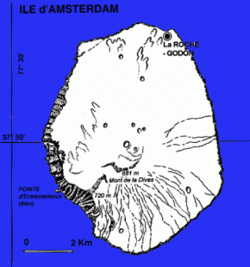

Location
| IAGA Code | : | AMS |
| Location | : | Ile Amsterdam (Terres Australes) |
| Organisation | : | Ecole et Observatoire des Sciences de la Terre (EOST) |
| Co-latitude | : | 127,796° |
| Latitude | : | 37,796°S |
| Longitude | : | 77,574°E |
| Elevation | : | 50 meters |
Instruments
| Absolute Instruments | : | Theodolite Zeiss + fluxgate probe (Bartington MAG01H) |
| Variometers | : | triaxial fluxgate variometer (Thomson VFO 31) proton precession scalar magnetometer (GSM90). |
Recording
| Orientation | : | HDZF |
| Dynamic Range | : | +/- 1000 nT |
| Resolution | : | 0,1 nT |
| Internal Sampling Rate | : | 0.1 sec |
| Data Sampling Rate | : | 1 sec |
| Filter | : | 47 points (Gaussian) digital filtering conforms to Intermagnet specification |
| K-Indices | : | FMI-method K9 - limit : 460 nT |
INTERMAGNET
| GIN | : | PARIS |
| Transmissions | : | via Emails every 12h U.T. |
Key dates
| 18 March 1522 | : | Discovery of Amsterdam Island by Sebastian del Cano |
| 18 June 1633 | : | Van Diemen give the name of his boat Nieuw Amsterdam to the island |
| 1950 | : | settlement of the base Martin de Viviès. |
| 1981 | : | settlement of the magnetic observatory |
History
The Amsterdam island (60km2) is a volcano related to an active transform fault. Lavas are tholeiitic in composition and are likely to originate from a shallow mantellic source. The permanent base Martin de Vivies was set up in 1950 in the north part of the island. At the beginning, it was dedicated to meteorological observations. The permanent magnetic observatory (IAGA code AMS) was established in 1981 by the formerly Ecole et Observatoire de Physique du Globe de Strasbourg (now Ecole et Observatoire des Sciences de laTerre).
The site selected to build up the observatory (altitude 50 meters) is located 50 meters above the sea level, on a slightly dipping plateau composed of solidified lava flows and tunnels. The observatory comprises two huts: an absolute hut and a variometer hut, installed between December 1980 and April 1981, about hundred meters away from the other buildings of the base. The variometer hut is located 15 meters NW with respect to the absolute hut. The recording laboratory is 120 meters NW away from the absolute hut. Since the opening of the observatory in April 1981, the infrastructures have remained unchanged.
The magnetic chart of the hut surroundings displays large local magnetic anomalies originating from the strongly magnetized basalt basement outcropping all over the island. The variation of the total field intensity between the absolute pier and the variometer pier reaches 400 nT.
Digital one minute data have been recorded continuously since 1981. An equipment for the INTERMAGNET program was added in December 1992. It consisted in a data collection plateform (DCP) for transmission via METEOSAT satellite to European Gin's.
Since May 17th 2010, new 1Hz Acquisitions Systems (M.A.R.Cell 1.0- Magnetic Acquisition and Recording Cell 1.0) were installed.
Absolute Measurements
The absolute pier (37.796 S, 77.574 E) has remained the same since 1981.
Absolute measurements are performed on average every tow days using the Declination-Inclination magnetometer D-I MAG88. This D-I flux is based on a Zeiss 010B non-magnetic theodolite fitted with a single axis sensor mounted on the telescope. Total field determinations are performed every 10 seconds with a proton Overhauser magnetometer SM90R. The accuracy of the absolute determinations is estimated 1 nT for H and Z, the equivalent of 1 nT for D, and 0.5 nT for F.
Variometers
The fluxgate variometer (VFO31) and the proton Overhauser magnetometer (SM90R) recording total intensity F are placed in the variometer shelter which is heated at a constant temperature of 25 degrees Celsius.
The triaxial variometer has a nominal output of 5 mV/nT and a dynamic of +/- 1000 nT. The long-term stability of the three-component variometer is better than 1nT/month.
Accuracy of data
The adopted baseline values are calculated by spline smoothing. The uncertainty in the adopted baseline values,as well in the final 1-minute values, is estimated to be less than +/- 2 nT for all elements. Most of the base line variations reflect the time varying local gradient between the absolute shelter and recording variometers, due to the temperature dependent magnetic properties of the basaltic rocks.
Reference of the data
Detailed description of the instrumentation and method of data reduction are given in the annual bulletin of the Bureau Central de Magnetisme Terrestre (B.C.M.T., Paris).
